Subject: Death by Modal Mugging
Filed under: Crimes Against Onboarding
Status: Case 009 – Active Investigation
Location: Every homepage between 2012 and now
Case Summary
The victim reports they’d barely stepped through the homepage when the attack began. One moment, curiosity. The next — FLASH! — a full-screen pop-up loomed out of the dark, demanding an email address in exchange for “10% off something you don’t yet know you want.”
Backup was called when secondary suspects appeared: a cookie banner blocking the retreat, and a “spin-the-wheel for discounts” modal cackling from above. Within seconds, the page was unrecognisable — a digital alleyway lined with false promises and broken accessibility.
Dectives arrived at the scene, trench coats still flapping, and immediately declared it “an act of Premeditated Engagement.” Witnesses were warned to shield their eyes and their inboxes.
The Evidence
- Number of sites that use aggressive ads, popups and idiocy 59%
- Sites that load an overlay dialog immediately on page load 40%
- Users who encounter a pop up on a website to subscribe 83%
- Unlikely or HIGHLY unlikely to subscribe 95%
Modals were once a helpful UI tool for focused interaction. But somewhere along the line, marketing took the scalpel and turned it into a shiv. The result: dark patterns masquerading as conversion strategies. The data proves it — users don’t feel “converted.” They feel cornered.
Sources:
Exhibits
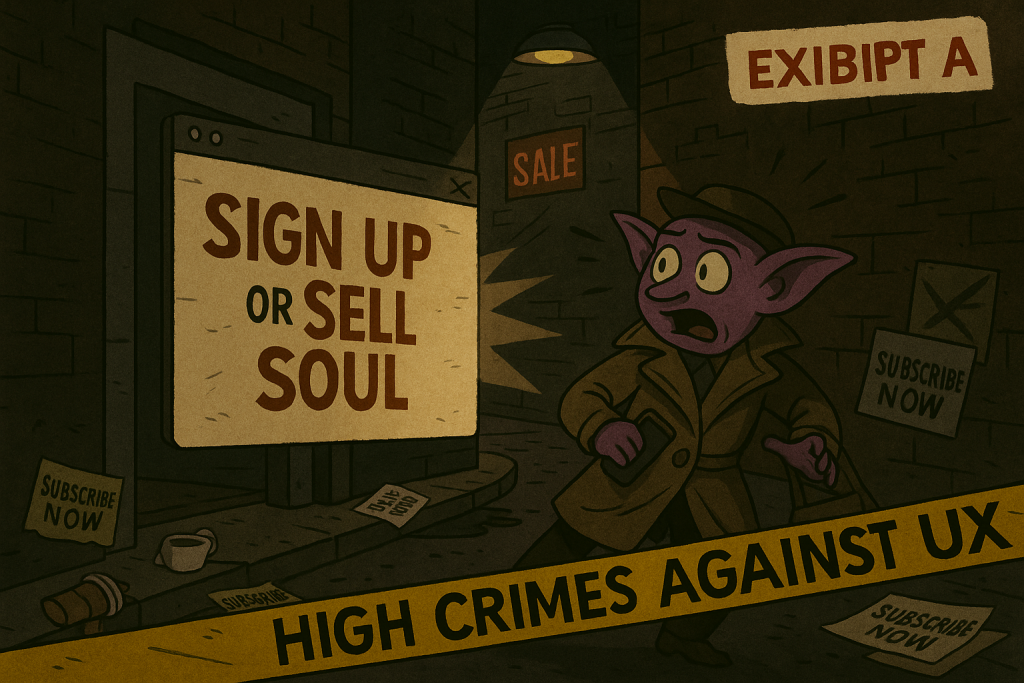
The victim had not yet scrolled, clicked, or consented. The site struck first.
Exhibit A: The Digital Alleyway
A reconstructed still from the crime scene. The homepage was barely visible before the attack began. Our victim, Polly Popover, steps cautiously into the glow of a fresh-loaded site — and immediately a full-screen modal lunges from the shadows. The background dims. The “content” disappears. All that remains is the coupon, shouting in 72-point typeface: “SIGN UP OR SELL SOUL.”
Forensics noted faint traces of curiosity near the navigation bar, but it never stood a chance. The modal struck first, with speed measured in milliseconds.
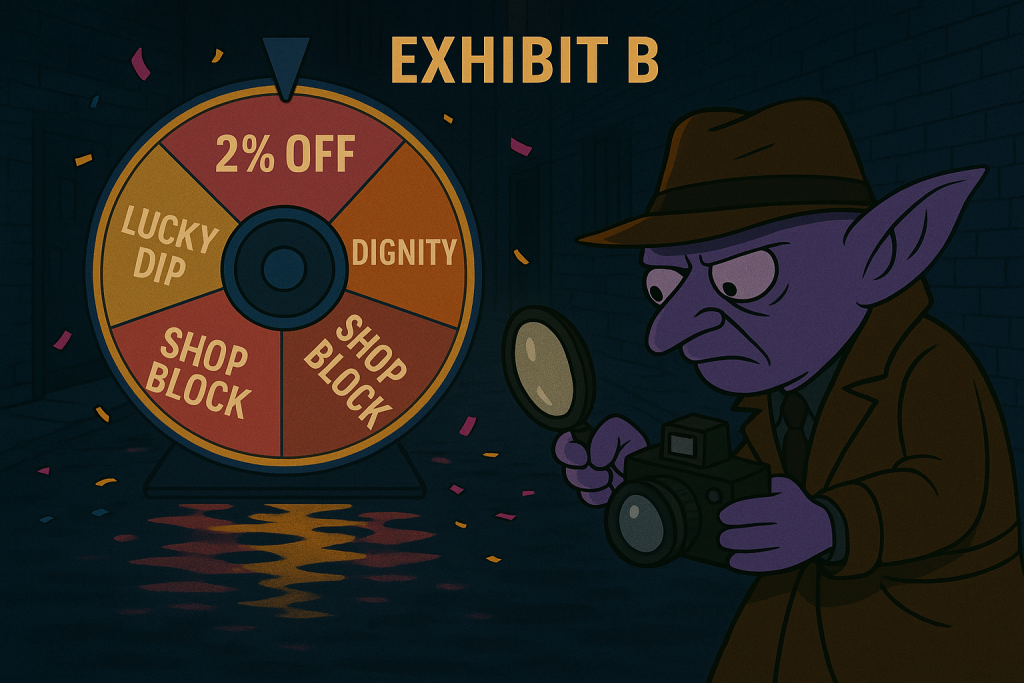
Psychological manipulation dressed as a game of chance. The wheel always wins — the user always loses.
Exhibit B: Spin to Win (and Lose)
Recovered from the scene moments after the initial ambush. Investigators discovered the secondary suspect: a neon “Spin to Win!” wheel glimmering under a single flickering light. Its lure was irresistible — free shipping, mystery discounts, eternal regret.
Polly Popover, still dazed from the alleyway attack, reported hearing faint carnival music before the wheel materialised on-screen, blocking her only escape route. Witness statements describe the wheel rotating endlessly, every slice reading “10 % OFF” except one marked “DIGNITY.”
Forensic sweep found evidence of confetti fragments, mouse-cursor burns, and three unanswered screams recorded in the site analytics.
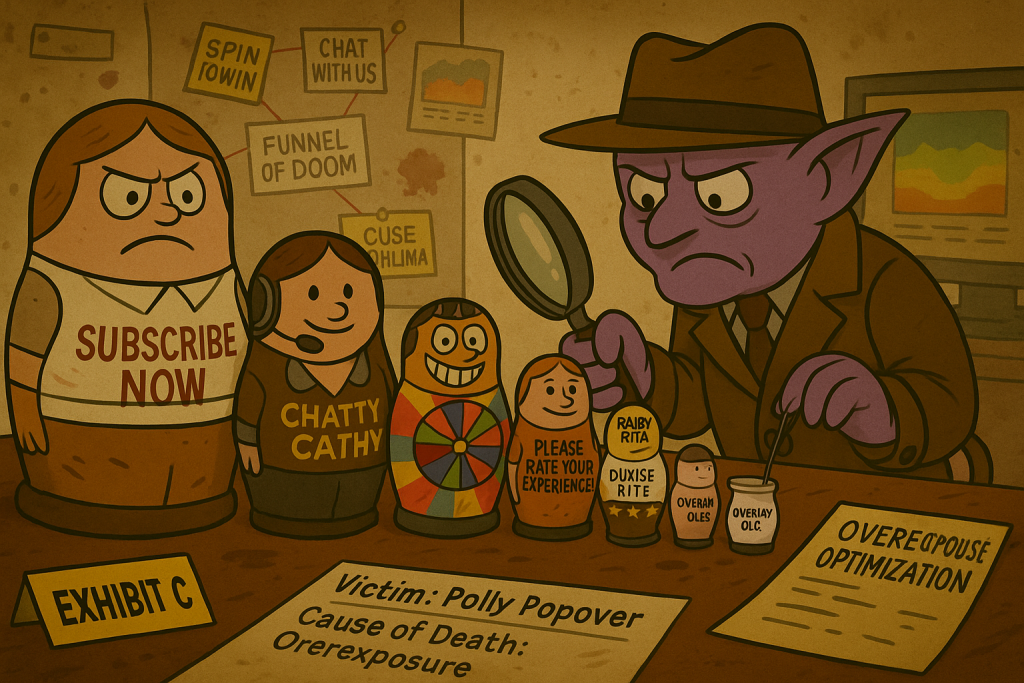
Marketing calls it a funnel. Forensics call it a burial site for attention spans.
Exhibit C: Layered Desperation
Captured during the second sweep of the alley, this scene reveals the full extent of the horror. Multiple pop-ups were found stacked like nesting dolls — a newsletter form over a cookie banner over a “chat now” invite. Each layer screamed for attention, yet blocked the others entirely.
Detective Goblin noted visible strain on the underlying interface. Page load speed had dropped to single digits. The site’s source code was described by one analyst as “a cry for help written in JavaScript.”
Polly Popover, already traumatised from the wheel encounter, could be seen attempting to close one overlay — only to trigger another. A digital Matryoshka of madness.
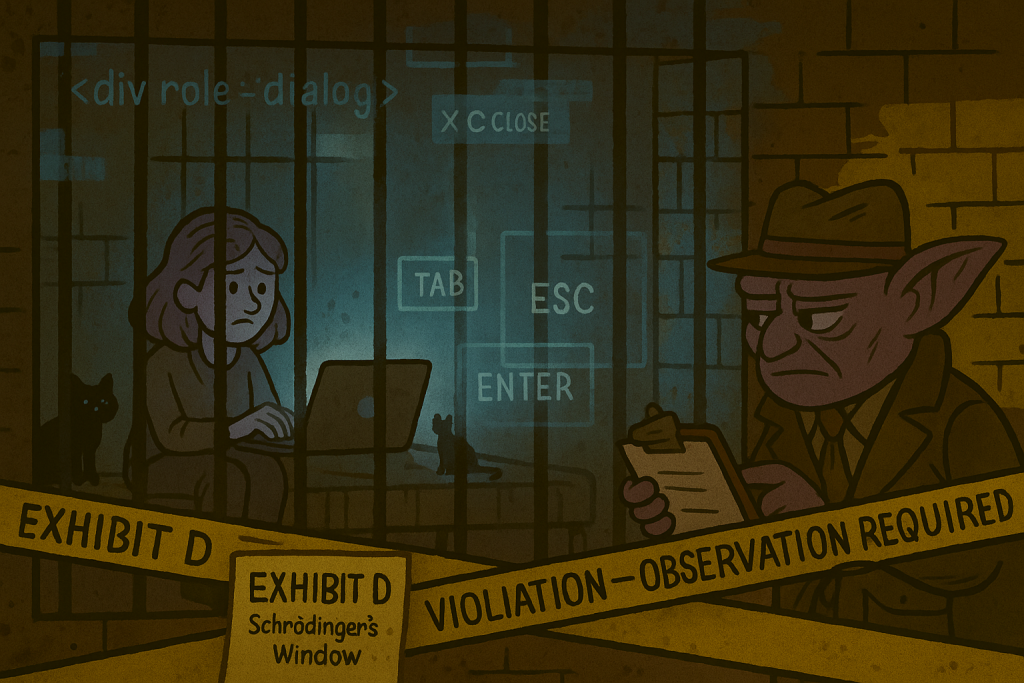
Digital unlawful imprisonment under Section 2.1 of WCAG and Section ‘Are You Kidding Me’ of Basic Human Decency.
Exhibit D: Escape Impossible
Recovered from Polly Popover’s final moments in the UX labyrinth. The forensics team found her last digital footprints looping endlessly through the same input fields.
The page displayed a focus trap, locking her inside a modal with no working “X” button and a hidden “Close” link disguised as a grey pixel. The tab key was worn down to a nub; her cries echoed in the ARIA void.
One accessibility analyst described the page as “a Schrödinger’s window — neither open nor closed, both obstructive and invisible.”
Motive
Metrics over meaning
At first glance, the crime seemed senseless — why would anyone ambush a user before they’d even seen the homepage? But under harsh interrogation (and a few too many dashboards), the truth emerged.
This was a conversion crime born of KPI panic. Somewhere, deep in a meeting room filled with half-eaten biscuits and ego, someone said:
“What if we ask sooner? What if we pop up faster? What if we catch them before they leave?”
And so, one by one, the culprits took form: Newsletter Nancy, Cookie Carl, Chatty Cathy, Wheelie Dealie, Offer Oliver, Ratey Rita, and the ever-silent Overlay Oleg. Each promised uplift. Each demanded data. None delivered delight.
The motive was classic: metrics over meaning.
In pursuit of higher “engagement,” they mistook intrusion for intimacy and confusion for conversion. Every success metric looked triumphant — while trust, comprehension, and accessibility flatlined.
The Trade-Offs
-
We captured more emails for remarketing
Half of them unsubscribed or marked you as spam within 24 hours. -
Bounce rate dropped slightly after adding a coupon modal
Because analytics stopped counting users who closed the tab in rage. -
The pop-up improved engagement with our loyalty programme
By confusing sign-ups with actual loyalty. -
Customers spend longer on site
They’re trapped in modals, not browsing — it’s digital Stockholm Syndrome. -
It boosts conversion rate!
It tanks reputation, trust, and accessibility compliance — but looks great in the QBR slides.
When contacted for comment, the Marketing Department issued the following statement through an intern clutching a ring binder labelled “Growth at Any Cost.”
“We categorically deny that our modals are intrusive. Our user engagement initiatives are designed to delight visitors and accelerate meaningful interactions at key decision points in the conversion funnel. Any resemblance to coercion, harassment, or psychological warfare is entirely coincidental.”
Victim Impact Statement
I came to browse. That’s all. One innocent click — and then they came for me.
First, the newsletter ambush — a bright, chirping box demanding my email “for exclusive access.” I hadn’t even seen what they sell. Then the wheel appeared. It spun, it screamed, it offered me 2% off something I didn’t want. When I tried to close it, I triggered another one.
By the time I reached the cookie banner, I was surrounded. I hit “manage preferences.” It laughed.
They stacked themselves higher and higher — newsletter, chat bot, special offer, feedback survey — until the screen was nothing but layers of need. The page stuttered. My cursor trembled. Somewhere in the distance, I heard a bell ding for “conversion.”
When I woke, I was in a dialog box with no escape. A grey “X” taunted me from the corner — visible but unclickable. I tabbed and tabbed, caught in an endless loop. The last thing I remember is a faint purr and a flash of fur. The cat was both there and not.
Now, whenever I try to browse, I flinch at the sight of a coupon. I see pop-ups in my dreams.
Guilty As Charged
After reviewing the evidence, cross-examining Polly Popover, and briefly interrogating a marketing intern named Brad, this court finds the defendant guilty on all counts of:
- Attention Theft
Knowingly intercepting user focus within 0.3 seconds of page load, with intent to convert by coercion. - Accessibility Assault
Repeated use of invisible close buttons, focus traps, and keyboard imprisonment. WCAG left in tears. - Premature Engagement
Soliciting personal data before establishing trust, context, or consent — in violation of all known laws of human decency. - Data Kidnapping
Unlawful acquisition of email addresses through deceptive discounts and mandatory sign-ups, often resulting in spam trauma.
Real-World Penalties for Accessibility Crimes
CNIL Fines Big Tech Companies 210 Million Euros for Cookie Violations
On December 31, 2021, the French Data Protection Authority (the “CNIL”) imposed a €150,000,000 fine on Google and a €60,000,000 fine on Facebook (now Meta) for violations of French rules on the use of cookies.
After receiving several complaints from users, the CNIL investigated the cookie practices of facebook.com, google.fr, and youtube.com. The CNIL’s investigations concluded that the websites offered an easy way to consent to the use of cookies immediately after accessing the websites, but did not provide an equally easy way to refuse the use of cookies. Users had to select multiple options to refuse cookies, but only one option to provide consent to the use of all cookies. The CNIL also concluded that Facebook provided unclear and confusing instructions to users on how to refuse cookies.
According to the CNIL, the companies’ cookie notices and consent practices affect the freedom of the website users’ consent, as it influences users’ choice in favor of consent.
Sources:
The National Law Review
FTC Report Shows Rise in Sophisticated Dark Patterns Designed to Trick and Trap Consumers
Tactics Include Disguised Ads, Difficult-to-Cancel Subscriptions, Buried Terms, and Tricks to Obtain Data
Sources:
Federal Trade Commission
“Dark Patterns” Targeted by EU Institutions: A New Era of Digital Fairness
Today, several major tech companies, including X (formerly Twitter), Meta, Shein, Temu, TikTok, and AliExpress, are facing legal action under the DSA, with accusations that include the use of dark patterns.
Sources:
Fair Patterns
Sentencing
Courtroom ambience: faint hum of fluorescent lights, a single popup flickers in the gallery.
“You stand before this court charged with crimes of digital assault, attention theft, and user entrapment. You were warned — repeatedly — by your own analytics dashboards. Yet you persisted. You dressed coercion as conversion. You mistook interaction for consent.”
Judge Goblin adjusts his spectacles, sighs heavily, and addresses the accused.
“This court recognises that you were not alone. Entire marketing departments conspired with you. Whole design systems turned a blind eye. Even product managers nodded along, muttering the ancient spell: ‘It’s just a quick win.’”
He pauses, tapping the bench with a well-worn stylus
“For the charge of Premature Engagement, I sentence you to six months of mandatory empathy training — no modals, no metrics, and no marketing dashboards until you can make a button that says ‘No Thanks’ and mean it.”
The gallery murmurs. The cat yawns.
“For the crime of Accessibility Neglect, you will serve a lifetime subscription to the WCAG 2.2 guidelines, read aloud by a screen reader in perpetuity.”
“And for your persistent Dark Pattern Deception, you are hereby condemned to rebuild your website… in plain HTML… under user observation.”
Gavel drops. Confetti from Wheelie Dealie drifts sadly to the floor.
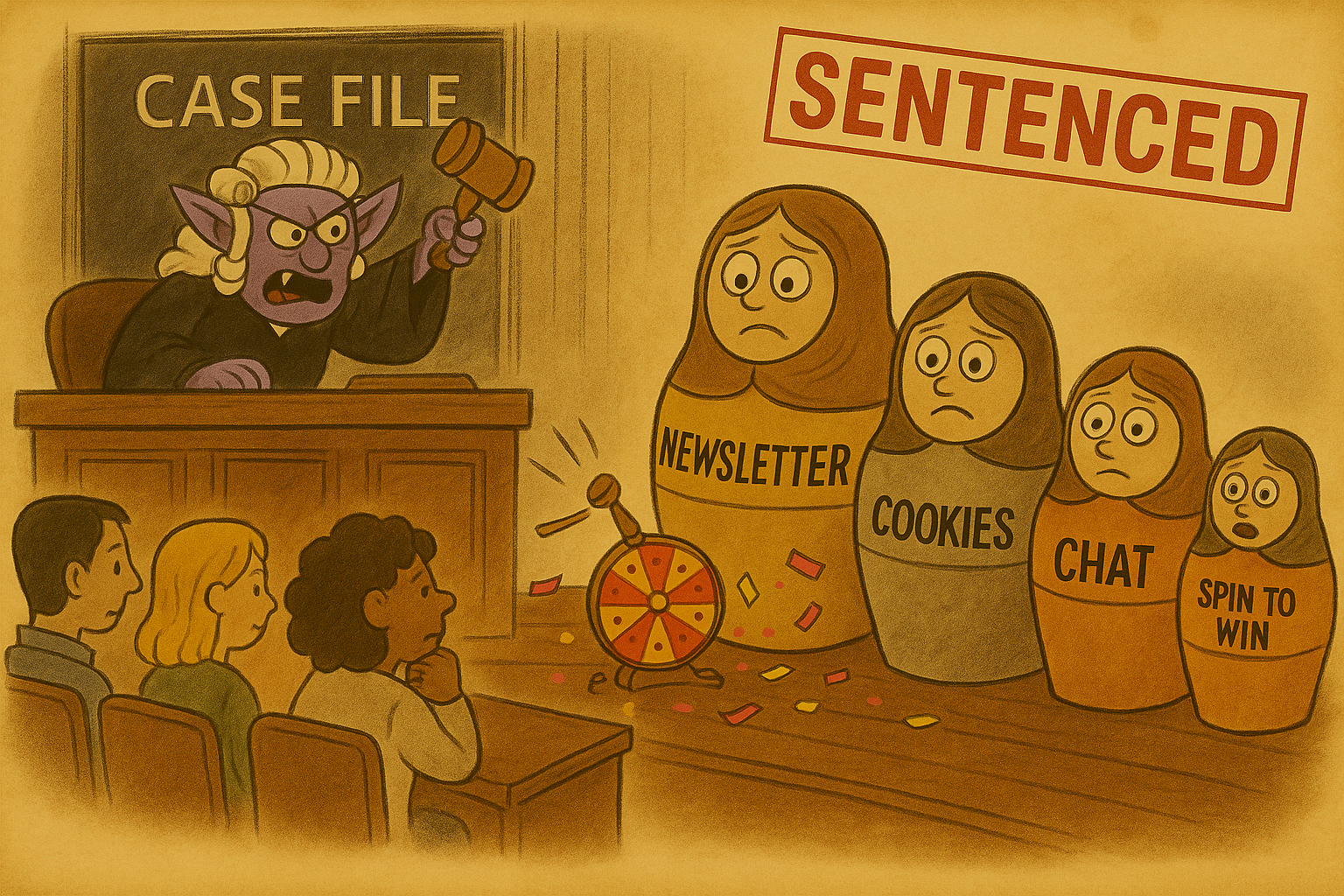
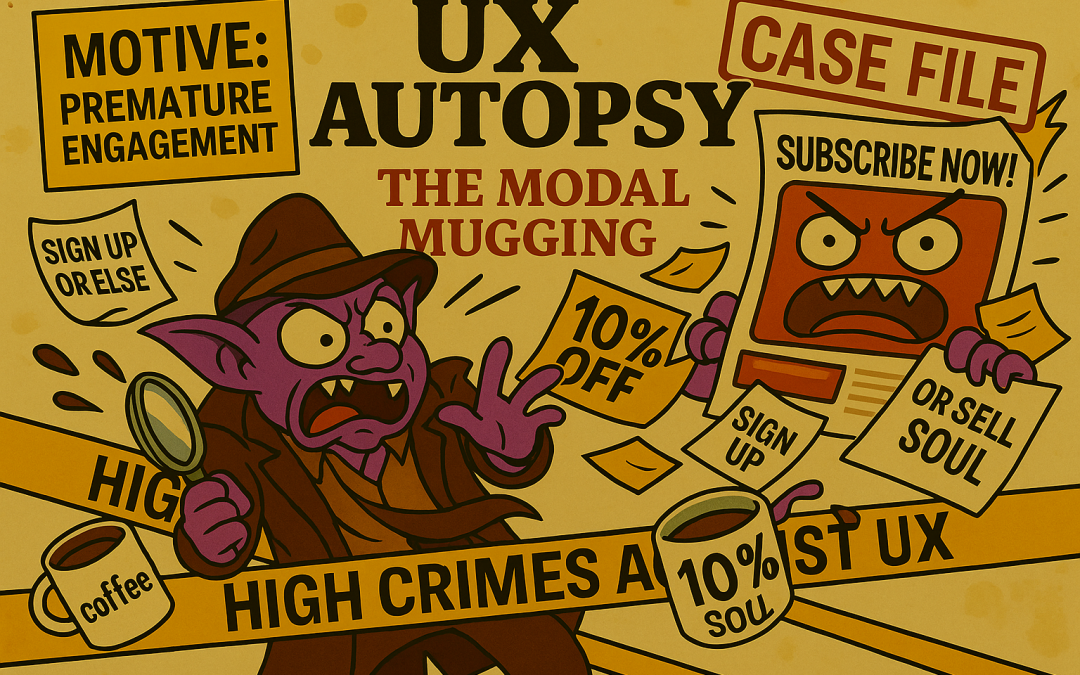
Recent Comments